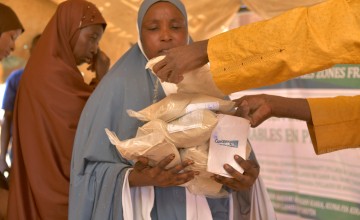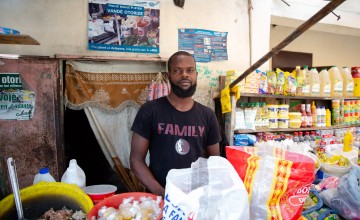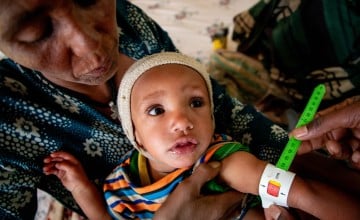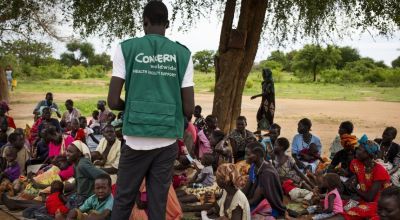
Read our 2023 annual report

Knowledge Hub
In 2024, that’s the 733 million-person question.
When we say that one out of every 11 people in the world are experiencing some level of hunger, what does that actually mean? Who comes up with that number? How do they get to that number? And can any one number ever give us the full story?
Read on to learn how we measure hunger in the big picture, as well as the methodology that Concern uses (in partnership with Welthungerhilfe) to measure hunger as part of our annual Global Hunger Index.
Who measures hunger?
At the risk of sounding like an old Abbott and Costello sketch, WHO does measure hunger. That is, the World Health Organisation — in partnership with the Food and Agriculture Organisation, International Fund for Agricultural Development, UNICEF, and the World Food Programme. Together, these UN organisations annually publish the State of Food Security and Nutrition in the World.
Known informally as SOFI, the report provides a headline number of undernourished people around the world. It’s this report we’re citing when we say that there are 733 million hungry people in the world.
However, one report doesn’t give us the whole story. In addition to the UN partners mentioned above, we also look to the Integrated Food Security Phase Classification (IPC) for ongoing monitoring of key food and hunger crises around the world. Most importantly, we look to the IPC for indicators when a country or region is experiencing famine or famine-like conditions.
Of course, other organisations also measure hunger — including Concern and Welthungerhilfe. We’ll talk more about our methodology below.

What is behind the 733 million figure?
The UN consortium behind SOFI uses the Prevalence of Undernourishment (PoU) to monitor hunger, an indicator based on country data on food availability, food consumption, and energy needs. The PoU measures how adequate a population’s intake of calories is compared to how much they need to function each day.
More accurately, what we’re saying is that 733 million people aren’t getting enough calories to function each day. But saying “Nothing kills like inadequate caloric consumption” doesn’t land the point as succinctly and simply as “Nothing kills like hunger” does.
Note: SOFI also tracks a larger number, which is global food insecurity. This data is self-reported via a series of eight simple questions that form what’s known as the Food Security Experience Scale. In 2024, SOFI reported this number as being 2.8 billion.
Metrics are a map, not a destination, and these two indicators give us valuable information in terms of where hunger and food security trends are moving over time. But these reports also take time to create, and we also need a statistically significant time window to measure. So when, in 2024, the UN announces that there are 733 million people in the world not getting enough food, this figure more accurately reflects the state of hunger in the world in 2023.

How do we measure hunger?
Each year, Concern — in partnership with German NGO and Alliance2015 partner Welthungerhilfe — publishes the Global Hunger Index. Like SOFI, the GHI is a peer-reviewed report that measures hunger, using slightly different criteria and a different methodology.
Every year, we assign countries a GHI score, calculated based on four key indicators:
- 1
Undernourishment
The percentage of a population (both children and adults) that is undernourished — i.e., receiving an insufficient number of calories.
- 2
Child wasting
The percentage of children (under the age of five) who suffer from wasting — that is, low weight for height. This is a sign of acute malnutrition.
- 3
Child stunting
The percentage of children (under the age of five) who suffer from stunting — that is, low height for their age. This is a sign of chronic malnutrition.
- 4
Child mortality
The mortality rate for children under five. Roughly half of all deaths in children before their fifth birthday are related to malnutrition, so this figure allows us to understand how severe food insecurity is in each country.
Much of our data comes from the same sources used for SOFI and by the IPC, including the FAO, UNICEF, and WHO, as well as the World Bank, the UN’s Interagency Group for Child Mortality Estimation (IGME), and the Global Database on Child Growth and Malnutrition.
What makes these factors different?
With the Global Hunger Index, we’re less interested in getting large, total numbers per country — the UN organisations and IPC already have that covered. Instead, by ranking countries based on an averaged score out of 100, we can look at hunger as though it were getting an annual report card. Which countries are making progress? Which countries are falling behind?
Tracking undernourishment rates is a way of measuring inadequate food access — an important indicator of hunger. Undernourishment is also a lead indicator for international hunger reduction targets, including the Sustainable Development Goals.

There’s a reason that three of our four indicators are focused on children: Children are more vulnerable to the effects of hunger and nutritional deficiencies (especially their organs and immune systems), and are in the early phases of growth and development compared to healthy adults. Measuring child wasting and stunting rates goes beyond measuring calorie availability and considers factors like the quality of a diet and the various nutrients that may be missing from the table. Tracking these figures against overall undernutrition rates also gives us a sense of how food is shared at home.
Child mortality is also a key factor as it’s the most serious consequence of hunger. Malnourished children are 11 times more likely to die before their fifth birthday, and tracking mortality rates against stunting and wasting rates gives us a fuller sense of the risk of undernutrition within any given country.
There’s no one “right” way to measure hunger
Ultimately, however, we can’t measure hunger the way we can measure a population. Even the GHI isn’t perfect as a means of calculating hunger. Often, we struggle to get complete data for the countries where we know certain factors to be alarmingly high (such as child mortality), leaving certain crises out of the spotlight with dire consequences for those who are most vulnerable to hunger and malnutrition.
Likewise, no one report is going to tell the full story of hunger. Behind every number is a person, and each person has a complicated and multifaceted life with many factors combining to change their circumstances from one day to the next.
What we tend to do, in this case, is look at our data on hunger against other reports, including SOFI and IPC updates. We may have different methodologies and results, but we often see trends that suggest we’re all coming to similar conclusions from different angles. What we know in 2024 is that hunger is on the rise, with fatal consequences, and it’s especially severe in countries on the frontlines of conflict or the climate crisis (or, in some cases, both). We know that hunger rates can vary drastically within a country, particularly along income brackets and between rural and urban communities.
We also know that, while the situation is grim, it’s not hopeless.
Other ways to help
Corporate support
Is your company interested in working together for a common cause?
Fundraise for Concern
From mountain trekking to marathon running, cake sales to table quizzes, there are lots of ways you can support our work.
Buy a gift
With an extensive range of alternative gifts, we have something to suit everybody.
Leave a gift in your will
Leave the world a better place with a life-changing legacy.
Volunteer with Concern
The lots of ways to get involved with our work as a volunteer
School fundraising
Without the generous support from schools, we wouldn't be able to do the work that we do.




